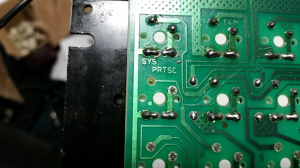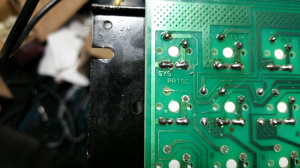You lifted a pad, for certain. I have circled it in green. I assume that these pictures are both sides of the board, of the same switch contacts. The side in which the pad is lifted is where the trace for that contact leads to the rest of the matrix, and appears to be the bottom of the board?

What I have highlighted in blue is part of the trace close to the original pad that you will want to expose by very carefully scraping away the red solder mask until you've got a decent amount of exposed metal beneath.
Your PCB has no pcb-mount holes, so I imagine the switches are secured in a plate? Otherwise, I fear any repaired circuit might be too weak to sustain a lot of use. You could try a few things to bridge the gap:
1) You could try to make a solder blob large enough to bridge the divide between the switch leg and the trace you've just exposed. This is probably the most technically simple thing to try, but in my experience, solder does not stretch as far as you might think without anything to stick to, and this is unlikely to work without using so much solder that you may inadvertently bridge other contacts in the process and/or cause further damage.
2) You could try to use a bit of good stranded, flexible wire, giving yourself just enough excess to easily solder one end to the exposed trace, and the other to the switch leg. This is probably the next easiest thing to try, and the most likely to lead to success for someone who hasn't done a lot of soldering. I imagine this may also even be a best-case scenario in case there ever were any force that were to move the switch leg around, as there would be little-to-no stress on the solder joints themselves, and especially the fragile PCB trace at the other end of the wire.
3) Do what I sometimes do and just use whatever random nonsense is lying around to bridge the gap. With a Unitek K151L I modded box jades into not long ago, I noticed that the PCB's quality, and quality control ... left very much to be desired. Somehow a single pad lifted even when properly using an electronic desoldering pump for mere seconds. I used a bit of the leg of a diode that I had previously trimmed off, as many of the board's original diodes had somehow all rusted through, and had to be replaced as well. This can take a very steady hand and some putzing to try to hold the bit of leg in place with a needlenose or tiny flathead while soldering one end, and then the other. Not securing it whenever heating will most likely cause it to just stick to the iron and float away with it when it is removed from the trace or leg. I did take pictures of this, they should help demonstrate the idea behind either using a bit of snipped leg, or wire.

